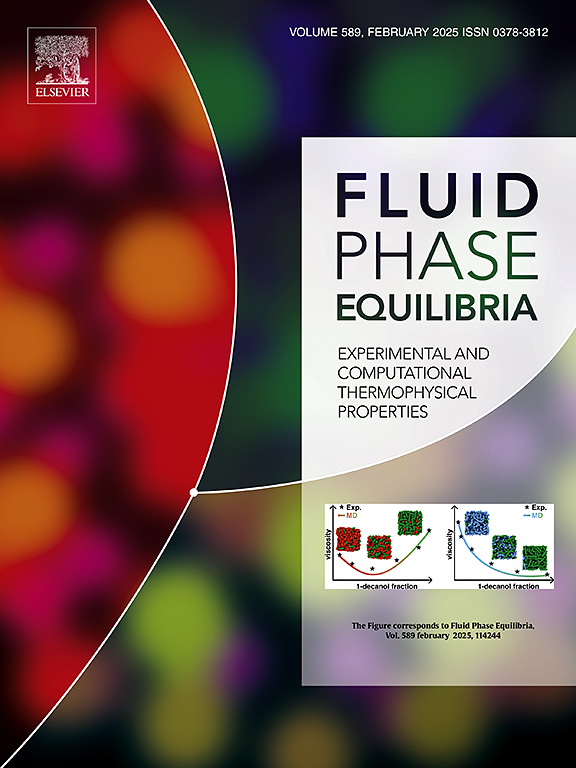测量单乙醇胺、二乙醇胺和2-氨基-2-甲基-1-丙醇的临界温度、压力和热扩散系数
IF 2.8
3区 工程技术
Q3 CHEMISTRY, PHYSICAL
引用次数: 0
摘要
测量了单乙醇胺(MEA)、二乙醇胺(DEA)和2-氨基-2-甲基-1-丙醇(AMP)的临界压力、临界温度和热扩散系数。这些化合物是用于捕获各种温室气体(主要是二氧化碳)的混合物的成分。采用适用于高热不稳定化合物的脉冲加热法测量其临界性质。在0.95置信水平下,临界温度的综合相对扩展不确定度为0.015,临界压力的综合相对扩展不确定度为0.036 ~ 0.047。计算了所研究的烷醇胺的偏心因子。本研究测量的烷醇胺的临界性质与文献数据以及Wilson和Jasperson、Nannoolal等人、Hukkerikar等人的群体贡献方法估计的值进行了比较。所有的基团贡献方法都低估了烷醇胺的临界温度和压力,只有一个例外:Nannoolal等人的方法估计的DEA的临界压力高于实验值。此外,还与使用三种SAFT状态方程(PρT-SAFT-HR、PC-SAFT和SAFT- hr)得到的烷醇胺的临界性质进行了比较。这些模型高估了MEA和AMP的临界温度以及MEA的临界压力,而低估了AMP的临界压力。在常压下,使用LFA 457 MicroFlash系统(Netzsch, Germany)用激光闪光法测量了MEA、DEA和AMP的热扩散系数;所涵盖的温度范围从303.15到373.15 K。用线性多项式来描述热扩散系数与温度的关系。根据热扩散系数的实验数据和文献中密度和热容的数据,计算了烷醇胺的热导率。热扩散系数和导热系数的综合相对扩展不确定度分别为0.05和0.06。利用本文获得的实验数据和文献资料,得到了MEA、DEA和AMP导热系数的计算公式。将导热系数的实验值与Govender等人的计算值进行了比较。戈文德及其同事的技术明显高估了烷醇胺的导热性。本文章由计算机程序翻译,如有差异,请以英文原文为准。
Measurement for the critical temperatures, pressures, and thermal diffusivities of monoethanolamine, diethanolamine, and 2-amino-2-methyl-1-propanol
The critical pressures, critical temperatures, and thermal diffusivities have been measured for monoethanolamine (MEA), diethanolamine (DEA), and 2-amino-2-methyl-1-propanol (AMP). These compounds are the components of mixtures used for the capture of various greenhouse gases, mainly CO2. The pulse-heating method applicable to highly thermally unstable compounds has been used to measure the critical properties. The combined relative expanded uncertainties at 0.95 level of confidence are 0.015 for the critical temperatures and from 0.036 to 0.047 for the critical pressures. The acentric factors of the alkanolamines under study have been calculated. The critical properties of the alkanolamines measured in this work have been compared with the literature data as well as with the values estimated by the group contribution methods of Wilson and Jasperson, Nannoolal et al., and Hukkerikar et al. All the group-contribution methods underestimate both the critical temperatures and pressures of the alkanolamines with one exception: the critical pressure of DEA estimated by the method of Nannoolal et al. is higher than the experimental value. In addition, such a comparison has been made with the critical properties of alkanolamines obtained using three versions of the SAFT equation of state (PρT-SAFT-HR, PC-SAFT, and SAFT-HR). These models of the SAFT EoS overestimate the critical temperature of the MEA and AMP and the critical pressure of the MEA but underestimate the critical pressure of the AMP.
The thermal diffusivities of MEA, DEA and AMP have been measured by the laser flash method using a LFA 457 MicroFlash system (Netzsch, Germany) at atmospheric pressure; the temperature range covered has been from 303.15 to 373.15 K. Linear polynomials have been used to describe the dependences of the thermal diffusivity on temperature. The thermal conductivities of the alkanolamines have been calculated from the experimental data on thermal diffusivity and the literature data on density and heat capacity. The combined relative expanded uncertainties are 0.05 and 0.06 for thermal diffusivity and thermal conductivity, respectively. The equations for calculating the thermal conductivities of MEA, DEA, and AMP have been obtained using the experimental data obtained in this work and taken from the literature. The comparison of the experimental values of thermal conductivity and those calculated by the method of Govender et al. has been performed. The technique of Govender and co-workers significantly overestimates the thermal conductivity of the alkanolamines.
求助全文
通过发布文献求助,成功后即可免费获取论文全文。
去求助
来源期刊

Fluid Phase Equilibria
工程技术-工程:化工
CiteScore
5.30
自引率
15.40%
发文量
223
审稿时长
53 days
期刊介绍:
Fluid Phase Equilibria publishes high-quality papers dealing with experimental, theoretical, and applied research related to equilibrium and transport properties of fluids, solids, and interfaces. Subjects of interest include physical/phase and chemical equilibria; equilibrium and nonequilibrium thermophysical properties; fundamental thermodynamic relations; and stability. The systems central to the journal include pure substances and mixtures of organic and inorganic materials, including polymers, biochemicals, and surfactants with sufficient characterization of composition and purity for the results to be reproduced. Alloys are of interest only when thermodynamic studies are included, purely material studies will not be considered. In all cases, authors are expected to provide physical or chemical interpretations of the results.
Experimental research can include measurements under all conditions of temperature, pressure, and composition, including critical and supercritical. Measurements are to be associated with systems and conditions of fundamental or applied interest, and may not be only a collection of routine data, such as physical property or solubility measurements at limited pressures and temperatures close to ambient, or surfactant studies focussed strictly on micellisation or micelle structure. Papers reporting common data must be accompanied by new physical insights and/or contemporary or new theory or techniques.
 求助内容:
求助内容: 应助结果提醒方式:
应助结果提醒方式:


